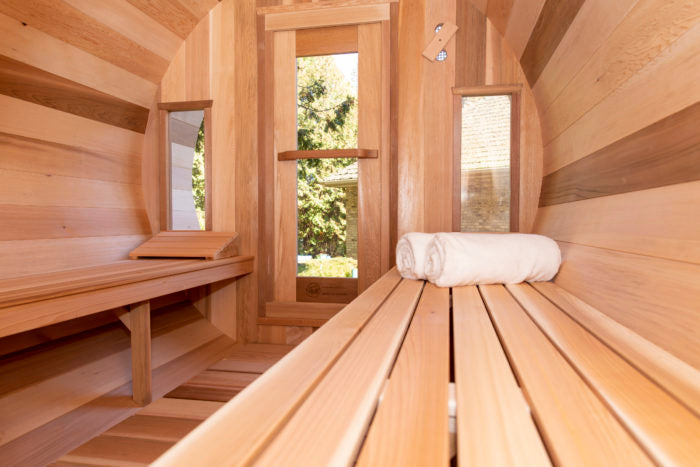The 45-Second Trick For Traditional Sauna
Table of ContentsSome Ideas on Traditional Sauna You Should KnowLittle Known Facts About Traditional Sauna.The Best Guide To Traditional SaunaTraditional Sauna - Questions
Many of the weight lost in a sauna is water loss and is re-gained upon rehydrating. However, undoubtedly sauna can be a fundamental part of a healthy weight-loss program. To take a look at the differences in between typical and IR saunas, I will certainly separate these into verifiable, academic, and produced distinctions.Thus, the hottest factor in the saunawhich is at the ceiling directly above the sauna heateris normally in between 185 and 190 F. Traditional Sauna. Claims that a typical sauna exceeds 200 F is simply not true and not relevant for electrical saunas marketed in the United States. The temperature level for a far-infrared sauna is typically established between 120 and 140 F; nonetheless, unlike the traditional sauna, the goal in and IR room is not to achieve a heat
As a result of this, the temperature distinction is almost pointless, because extreme sweating causes both sauna types, yet the technique of heating the body is various. In an IR sauna the bather will certainly really feel warm and will certainly sweat a lot, yet at a lot reduced temperature levels. Therefore, if the objective is to spend longer periods of time in the sauna, the IR sauna is an excellent selection.

Some Known Questions About Traditional Sauna.
When the heat is accomplished, the aspects cycle on and off to keep the high temperature level. Many typical sauna customers delight in putting water over the rocks to develop vapor to raise sauna humidity levels. The advantages of pouring water over the rocks include: making the area extra comfy, dampening the nasal flows, and allowing the use of aromatherapy by mixing vital oils with the water.
In a far-infrared sauna, the warm front permeate the body to properly heat up the body and elevate the body core temperature level. To accomplish this boosted temperature level, Far-infrared emitters create infrared energy which is close to the same wavelength as that which the her explanation body normally emitsoften described as the "Important Array" of 7 to 14 microns), so the energy is well received by the body.
When the power enters the body, it causes the body temperature to enhance and eventually causes sweat. In an infrared sauna it is very important for the emitters/heaters to remain on almost constantly. Because there is no mass of rocks to maintain heat, the sauna will certainly cool down if the emitters closed off.
As stated over, the sauna bather in an infrared space intends to position himself before running emitters to get maximum benefit from the warm. The heating time for both rooms can be extremely various, depending on exactly how the areas are made use of. For a conventional sauna, a bather ought to permit 30-40 minutes for the space to attain a wanted temperature level and to correctly pre-heat the rocks.
Not known Incorrect Statements About Traditional Sauna
A well built sauna will commonly accomplish a temperature level of 150-160 F in regarding 30-40 mins. For hotter temperatures, the area may need to warmth for a longer Find Out More period.
To some, 15 mins was "wasted" while the infrared energy heated up the timber panels as opposed to heating up a body, while others discover a pre-heated space to be more comfy and believe an elevated beginning temperature is required to begin perspiring. The length of suggested use for each and every room is about the exact same (10-15 minutes per session); nonetheless, as a result of the reduced air temperatures and the capacity to feel the impacts of infrared heat quicker than a conventional sauna, it is not uncommon for a person to invest an overall of 20-30 minutes in an infrared sauna.
Traditional saunas tend to be bigger (thus use more electrical power) than infrared saunas, although typical saunas are absolutely available in one and two individual dimensions. For a two-person typical sauna, 5x6 or 5x7 size is most prominent. The top bench can easily seat two or three people and is also long sufficient to exist down during the sauna session.


The average cost per kWH of electrical energy in the united state is about $0.11, so a 4.5 kW heater will certainly set you back roughly $.50 to run for one hour, if the heating system runs continuously for one hour. Generally a sauna heating system will certainly run for 75% of the first hour and recommended you read 50% of subsequent hours on because the components cycle once the established temperature is accomplished.
Traditional Sauna Can Be Fun For Anyone
A 2 individual far-infrared room is normally literally smaller sized than a conventional sauna, commonly concerning 4' x 4' or smaller. The IR heating unit is usually 1.5-1.7 kW making use of a 120 volt 15 amp plug-in service. Given that the area can be used quicker than a sauna room, we will presume the space is used for to of an hour including warm up time.
Finally, there is a hardly ever reviewed difference in the social experience between the 2 spaces. While our society has shed some of the social advantage of the conventional sauna experience, it can be very socially gratifying. From family members time in the sauna, to heart-felt conversations with significant others, to sauna partiesthe standard sauna experience can lead to intimate interacting socially.
A lot of higher end infrared spaces consist of tinted light treatment, sound systems and full-glass fronts.